Conception and Implantation
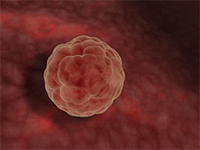
At conception, the egg and sperm will meet, creating a single cell organism called a “zygote”. If the egg was fertilised, it will drop into your uterus. Once the fertilised egg (orzygote) is in your uterus, fluid will enter dividing it into two. One will be the placenta; the other will be the baby.
A blood pregnancy test may show positive as early as or at around eight days following implantation of the egg.
Implantation typically occurs 6 to 10 days after ovulation, or day 20 to 24 of a menstrual cycle. In an average, 28-day cycle, ovulation occurs on day 14 (the first day of a period is considered day 1 of a cycle). Once fertilisation occurs, the egg stays in the fallopian tube for 3 days before entering the uterus and begins to implant in the uterine lining.
Implantation is usually a quite gentle process, with very few symptoms. A very small amount of spotting (implantation bleeding) may occur for a short period of time.
Your should
- Stay away from alcohol, smoking, drugs and medications (including herbal ones).
- Eat a well-balanced diet
- If you aren’t already, start taking prenatal vitamins including Iron, Iodine and folic acid (a vitamin that helps reduce the risk of neural tube defects) regularly. Folic acid is also found in green leafy vegetables, citrus fruits and juices, enriched bread and cereals, and more.
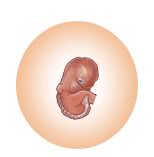
The baby is roughly the size of a poppy seed and now entering the phase of development known as the embryonic period. The cluster of cells that is becoming baby has settled into the uterus. One-half of the cells become the placenta while the other half becomes the baby. The baby cells divide further, into three groups:The inner layer (endoderm) which develops into the digestive system, liver, lungs, pancreas and thyroid.
- The inner layer (endoderm) which develops into the digestive system, liver, lungs, pancreas and thyroid.The middle layer (mesoderm) which becomes
- The middle layer (mesoderm) which becomes the heart, reproductive organs, bones, kidneys and muscles.
- The outer layer (ectoderm) which becomes brain, spine, nerves, skin, hair, eyes, teeth, sweat and mammary glands.
The amniotic sac and yolk sac are forming now as well. The yolk sac eventually will become part of the digestive system. Early pregnancy symptoms are quite similar to premenstrual syndrome (Bloating, cramping, mood swings, fatigue, headaches, backaches, breast tenderness, etc…) This is a great time to find out about which foods you should or should not be eating:
- Which foods you should or should not be eating?
- What are the exercises you should or should not do?Will you need to make some changes at the worksite?
- Will you need to make some changes at the worksite?
- What is the maternity leave policy at your job?
Check the safety of any prescription or over the counter drugs you may be taking.
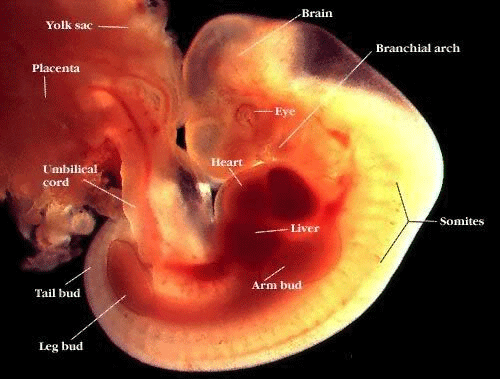
The heart starts beating and pumping blood.
The placenta and the umbilical cord start developing. The placenta is attached to the inside of the uterus and is attached to the baby by the umbilical cord. The umbilical cord carries blood between placenta and fetus. The placenta is the transfer point between mother and baby.
Most organ development is underway, including the lungs and brain.
Arm and leg buds appear.
The embryo is 6.5 mm (¼ inch) long at the end of this week, close to the size of a grain of rice.
Nausea generally starts at week six. One of the best remedies is to prevent it by eating frequently. An empty stomach quickly becomes a sick stomach in early pregnancy. Keep crackers on your nightstand and nibble on them as soon as you wake up.
Breasts tenderness is usually the initial symptom of pregnancy. Some experience extreme breast tenderness, while others might feel odd and tingly sensations.
Frequent urination, this symptom comes and goes throughout pregnancy.
Fatigue is most likely the most problematic symptom. It might be mild and not last all day, or you might feel completely knocked out all day, every day for several weeks. You may need help from friends and family members. Simplify household chores as much as you can.
The easier your schedule and chores, the easier pregnancy will be for you.
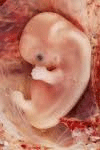
Your baby is now 12.5 mm (½ inch) long.
Baby’s head is really starting to take shape, with the jaw, nose and palate forming. The eyes are becoming more defined. The brain continues to become more detailed and complex.
The hands and feet have webbed structures that will become the fingers and toes
Other organs taking shape include the kidneys and liver. The intestines are starting to grow, however they are not located inside the baby yet, but rather are growing inside the umbilical cord.
Heartburn, try to eat frequent smaller meals. Also, try elevating your head and chest at night to avoid it. If persisted, try Mylanta. Mylanta is an antacid which acts locally and not absorbed into your system.
Breast tenderness is more prominent and the areolas might be darkening, and the breasts may start swelling now.
Worsening of frequent urination because the enlarging uterus is pressing against the bladder. Do not avoid drinking plenty of liquids in order to avoid having to visit the bathroom so often. Adequate hydration is essential for a healthy pregnancy. Later in pregnancy, the uterus will lift up into the abdomen and the necessity to go to the bathroom so often will lessen.
Light bleeding or spotting is common in early pregnancy. This is often nothing to worry about. However, bleeding that is continuous or becomes heavier, and is accompanied by pain indicates a real need to get to the doctor. However, if ever you are concerned about something you should go ahead and call your doctor.
Your first doctor’s appointment will be a longer one than normal:
- You will answer lots of questions about your personal and family medical history, including information about your previous pregnancies and any history of congenital or genetic conditions in the family.
- Your doctor will also talk to you nutrition, exercise and any unhealthy habits like smoking.
- Your doctor will give you your due date at this visit
- Your doctor will perform a thorough physical examination. Your weight, height and blood pressure will be checked.
- A Cervical Screening can be done if it is due. It is safe.
- You will also give a urine sample.
- Antenatal screening blood tests and dating scan will be requested
- You will be given your antenatal card
The baby is approximately 25 mm (one inch) long at the end of this week.
Now every organ has begun to form. The hair has started to grow. The eyelids and tongue are forming as well. The trunk is straightening out more. The elbow is busy bending and flexing, but you’re still unaware of the jabs and pokes. The brain is growing rapidly
Morning sickness is truly underway at this point. It affects up to 75% of pregnant women, and the average length of this symptom is about six weeks. Besides small frequent meals, try to avoid lying down after a meal. Vitamin B6 can help. If your sickness is accompanied by vomiting and you just can’t get it under control, talk to your doctor. Sometimes morning sickness goes beyond typical and into a condition called hyperemesis gravidarum. It’s severe morning sickness. If this is the case, your doctor will want to see you, possibly have medicine, or if need be, put you in the hospital for IV treatment and observation.
The Breasts may have gone up to a full cup size by this week. They are likely quite tender, and swollen. The nipple is probably standing out more than normal, just more pronounced. All these changes are due to the two major hormones, oestrogen and progesterone. Fat tissue is building up in the breast area, and the Montgomery tubercles (sweat glands on the breasts), are visible now.
When you visit your care provider, bring a notepad with all your questions (you won’t remember!) and ask questions without reservation. Get the information you need and don’t feel badly for doing so.
Have you started thinking about your birth plan yet? Yes it’s early, but the sooner you and your care provider have ironed out some major issues the better.
It’s never too early to start searching for the perfect name.
Living with early pregnancy symptoms can take a toll on you and your partner. It’s not unusual due to all the fatigue, nausea, and pressure for mom to become cranky at times. Growing a baby is no small feat, and those early weeks are some of the hardest.
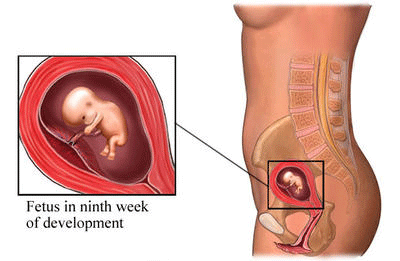
The baby is now about 25 mm long and weighs 2 gm basically about a grape size.
At this point in the pregnancy, the baby has switched from focusing on development to gaining weight.
The head is more baby-like, with ears more prominent, and eyelids are formed, with eyes now tightly shut until week 28 or so, when the eyes will open.
The joints (shoulders, knees, elbows, ankles, and wrists) are flexing and functional, but you still cannot feel them.
The heart which is beating strong at this point is developing the valves now.
The new organs on the scene are the liver, spleen and gallbladder.
Bloating, making your clothes tight, and heartburn continue to be problematic.
Mood swings, due to rising hormones levels in your system. You might be feeling good, when all of the sudden, you feel overwhelmed and teary.
If you are over the age of 35 or have a family history of genetic conditions, your doctor will probably discuss the option of prenatal diagnosis.
Now is a good time to start looking for ideas for the nursery, and get an overall plan for what kinds of things you want for baby’s room.
The baby is now over 50 mm (2 inches) long, and weighs about 7 gm (¼ of an ounce). This is roughly the size of a small lime
The internal organs are continuing to grow and most are functioning, while the liver, kidneys, brain and lungs are maturing.
The head makes up half the length of the fetus. Detailed features (hair, finger and toe nails) are now visible.
The baby is actively swallowing the amniotic fluid, and producing urine and digestive juices. Baby boys’ testes are functioning by producing testosterone.
The placenta will start functioning fully over the next couple of weeks.
Your appearance is changing. You might notice roundness in your lower abdomen, depending on your build. That’s because your uterus is now the size of a small grapefruit.
Due to the substantial increase in blood production, veins are most noticeable on your breasts and also in your hands and feet.
Constipation is caused by increase levels of hormones in your system, which relaxes the muscles of the large bowel. Make sure you drink plenty of water, eat plenty of whole grains and vegetables, and get regular exercise.
Headache is another common symptom in early pregnancy. These can be troublesome, and you can take paracetamol “panadol”, it is safe.
Nuchal Translucency Screening, this test is normally done between weeks 11 and 14 and uses both ultrasound and blood test results. It is a screening test for chromosomal abnormalities, notably Down syndrome. This test is not invasive, but does carry some risk of a false positive. When done at 11 weeks, the test picks up over 85% of Down syndrome cases
This is a good time to start considering options for what you’ll do after baby arrives. You want to start considering your options early.
- Will you be working fulltime, part-time or stay home fulltime?
- If you’re working, will you have a family member available to provide care, or will you need a day-care?
Things to help you coping with stress
- Yoga
- Breathing techniques
- Meditation
- Relaxation tapes and music
Lie down and let yourself unwind for a bit every day.
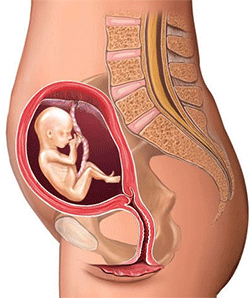
The baby is now the size of a large plum, about 8 cm (3⅓ inches) long and 28 gm (1 ounce) at the end of the week.
Baby is looking more adorably baby-like as the eyes move closer together, and the ears are settling into their final position. The nervous system is developing and fine-tuning, leading to the arrival of reflexive actions such as sucking.
The organs are formed and functioning, the pancreas is producing insulin, the pituitary gland is producing hormones, and bone marrow is producing white blood cells.
Many symptoms are lessening or leaving altogether, such as nausea, tender breasts, and fatigue, as the first trimester near end.
Dizziness or fainting might be a problem and is due to:
- The hormone, progesterone increasing blood flow and relaxing blood vessels
- Pregnant women often suffer from lowered blood sugar
Make sure to:
- Eat frequent small meals
- Getting enough rest
- Always stand up slowly.
Your uterus is now the size of a large grapefruit, and is moving out of the pelvis to the abdomen, which should relieve some of the pressure on the bladder and lessening the frequency of urination. Every visit the doctor will be palpating the uterus through the abdomen; this will be a main component of your antenatal visits.
Since the nausea and queasiness of the first trimester should be subsiding now, it’s a good time to start looking seriously at diet and nutrition issues. Have a balanced diet of a variety of fruits, vegetables, whole grains and proteins. Nuts, raisins, cheese, yogurt, and fruit are good choices. You need about 300 extra calories daily, in general.
Roughly the size of a peach, the baby is about 95 mm (3 ¾ inches) long and weighs about 35 gm (1 ¼ oz).
The baby continues to develop externally to look more human-like:
- The head goes from being ½ the length of the body to ⅓.
- The neck is lengthening and baby’s chin no longer rests on the chest.
Baby’s growth is now a more individual thing, with growing patterns varying greatly.
The baby is now practicing inhaling and exhaling.
A fine growth of hair covers the baby now and will grow until the 26th week of pregnancy. It protects the baby’s skin from the amniotic fluid.
The placenta provides all nourishment for the baby now.
Leg cramps, caused by the increase of oestrogen. Try to not sit for extended periods of time without little breaks. While sitting stretch out your legs and do little circles with your ankles.
Vaginal discharge “leucorrhea”, thin, milky mildly odorous, discharge helps protect vagina from infection but will require you to wear panty liners.
Colostrum, the pre-milk substance can be expressed during the second trimester, and is a light yellowish, sticky consistency.
Stretch marks may start forming on breasts and abdomen, characterized by their pink or reddish streaky appearance. Up to 90% of pregnant women experience them, but they will fade after you give birth. Things which might help alleviate them:
- Avoid rapid weight gain
- Lotions containing vitamin E or alpha-hydroxy acid
- Exercise
In most cases, couples can continue a healthy sex life right up to delivery, however there are a few conditions that will restrict sexual activity. If you or your partner feels anxious about whether it’s really safe or not to have sex, you should definitely speak to your doctor to ease your concerns. Some conditions that may require you to abstain include:
- Unexplained vaginal bleeding
- Placenta Previa
- Incompetent cervix or dilating cervix
- Sexually transmitted diseases
- Water has broken
The baby is close to 10 cm (4 inches) long, and weighs just under 56 gm (2 ounces).
Your baby’s arms are growing longer and becoming more proportionate to the body. The bones continue to harden.
The liver is producing bile, and the spleen is producing red blood cells.
The brain’s development has given rise to a new range of expressions (grimace, frowning, squinting, etc…).
For boys, the prostate is growing, while for girls the ovaries have migrated from the abdomen to the pelvis.
The skin is still transparent.
The second trimester begins, marking the end of the most critical development, and best of all the risk of miscarriage is now greatly diminished.
Mood swings may start to be more problematic at this point in the pregnancy. All is due to hormones surging. Of course, this is not the same as a persistent sadness. If that continues more than two weeks, consult your doctor.
Ligament pain, this pain is caused by the growing uterus stretching muscles and ligaments on the lower sides of the abdomen. Getting up suddenly, or switching positions rapidly can bring these pains on, so try to move gently from one position to the next.
Amniocentesis, if you are over 35 years of age, have a family history of genetic disorders, or received screening test results that indicated a high risk of Trisomy, your doctor will discuss the need for amniocentesis. The procedure is typically done between the 15th and 18th week of pregnancy and involves a needle being inserted through the abdomen and collecting some amniotic fluid to test for genetic disorders. It is highly effective at determining the presence of such problems. However, there is a risk in the range of 1:200 of causing miscarriage.
Now is a good time to planning the nursery.
The baby is the size of an orange, being over 10 cm (4 inches) long and weighing around 70 gm (2 ½ ounces).
The legs are now longer than the arms, and the body is longer than the head.
The eyes and ears are getting close to their final position. The eyebrows are becoming visible, and hair is sprouting atop the head. The ears are also developing inside, with the three tiny bones of the inner ear functional; however, the auditory sections of the brain are not yet prepared to process sounds.
The bones are hardening still, but have progressed to the point that they are visible now on x-rays. As you enter the second trimester, your total weight gain is most likely around the five pound mark. Don’t worry if it’s less, there aren’t hard rules about it, and every pregnancy is different.
Your uterus has probably reached 4-5 inches below your navel.
One topic every pregnant woman needs to know about is preterm labour.
The symptoms of preterm labour include
- Watery fluid leaking from your vagina
- Menstrual like cramps
- Low dull backache
- Pelvic pressure
Some of the risk factors include
- Multiple pregnancy (twins, triplets …)
- Previous premature delivery
- Abnormalities of the uterus or cervix
- Infections
- No prenatal care
- Being over or underweight
- Alcohol, smoking or illegal drugs.

The baby is now around 85 – 100 gm (3 – 3 ½ ounces) and is 11.5 – 12.5 cm (4 ½ – 5 inches) in length.
The baby and the placenta are now roughly the same size. Every day, the baby is looking more like an adorable newborn, with fat deposits building up under the skin, and the neck and head straightening more, also the eyes and ears have moved into their final position. The eyes can perceive light although the eyelids remain sealed shut.
The Baby’s heart rate is twice yours.
The 50% increase in blood circulation gives mom that pregnant “glow”
Baby’s movements, this exciting moment of pregnancy occurs anywhere from week 16 to week 20, depending on mom’s build, position, and if this is first pregnancy. The way the movement has been described ranges from butterfly fluttering sensation, a bubbling, to a tickling feeling.
Nasal congestion is one of the symptoms pregnant women experience around this time of pregnancy. Saline nose spray, nasal strips and using a humidifier can be very helpful.
The baby has now reached the point of development where gender may be able to be detected on ultrasound. It’s time to decide now if you want to know the sex of the baby. While it might be fun and exciting for some couple to find out at the birth, many others feel it helps them to prepare for the child better if they know ahead of time. They can plan the nursery, buy gender specific clothing, and narrow in on name choices. Some even say they feel more closely bonded with the baby when they know their child’s gender before the birth.
Baby’s hearing has become so sensitive that loud noises might startle him or her. The eyes face forward, but are still tightly closed.
Cartilage continues to harden into bone, but will remain soft enough to manage the birth process with necessary flexibility.
Fat tissue is forming, giving the baby a normal appearance, but it also helps with maintaining the metabolism, and regulating temperature. Additionally, fat pads are forming on the fingertips and toes and in a few weeks, the swirls that differentiate us by our fingerprints, will appear in a few more weeks.
The enlarging uterus is becoming more round and as it grows will move other organs out of the way. It’s sometimes possible for you to palpate your own abdomen and feel how the uterus is growing. This is easier to do when standing.
There will be a steady increase in your vaginal secretions “leukorrhea”. You might also notice an increase in your appetite this week. Don’t attempt to eat for two.
Sciatica, while it’s not directly tied to pregnancy, pregnant women often deal with this condition. It’s most likely linked to disc problems, which may become worsened during pregnancy. The sciatic nerve is a long nerve running from the lower back to the feet. The common description is like
- Pins and needles sensation associated with a leg falling asleep
- A shooting or burning pain
This sensation may occur in the lower back, leg or perhaps the foot. Applying heat, correct posture, physiotherapy, chiropractor or massage can help. Sometimes the problem clears up on its own within several weeks.
The baby is now 12.5 – 15 cm (5 – 6 inches) long and 140 – 170 gm (5 and 6 ounces).
The baby’s nervous system continues to become more refined and detailed in development, with the myelin (protective covering over the nerves) forming. This aids in messages travelling across the nerve pathways. The myelin continues growing until the baby is one year old.
Other not so easily seen development includes the formation of the alveoli, or the tiny air sacs in the lungs.
If the baby is a girl, the fallopian tubes and uterus have settled into their permanent position now.
The baby’s skin is being protected from the watery environment of the uterus, by vernix (a cheesy, greasy substance) and the lanugo-a fuzzy hairy growth on baby’s skin.
Low Blood pressure is becoming more problematic now. Rising from a seated position will make it worse. Avoid lying on your back now, and try to lie on your side.
Backaches, the common causes of backache are as follows:
- Pregnancy Hormones (relaxes your muscles and ligaments)
- Weakened abdominal muscles
- Incorrect posture
Morphology ultrasound will give a more in depth look at the organs and the development. This ultrasound may last longer than the typical sonogram done earlier in the pregnancy.
Make certain you are getting plenty of sleep at night, which can become increasingly difficult with the symptoms you might be contending with, such as aches and pains, gas, heartburn, and leg cramps. Try getting some little naps or rest periods during the day. If you are at work, take a little time to put your feet up, close your eyes and do some relaxation exercises. Even just a few minutes here and there can add up to some relief.
This week the baby is weighing 200 – 225 gm (7 – 8 ounces) and 150 – 175 mm (6 – 7 inches) long.
Now the baby’s sleep patterns are established, with the baby having periods of wakefulness, and periods of rest.
In baby girls, the vagina, uterus and fallopian tubes are in their proper places, and have several million eggs in their ovaries. In baby boys, genitals are completely formed and easily recognizable now.
The baby’s milk teeth buds have been present for some time, but now the buds for their permanent teeth are forming behind the milk teeth buds.
The kidneys produce urine daily now.
Leg cramps, this is a frequent complaint, often occurring while in bed. If you get a painful leg cramp, just stand up on it and stretch it out straight and flex your foot back towards your body to quickly alleviate the pain.
Parents who are expecting a son, have a decision to make “Circumcision or not”
After extensive review of the literature, there is no medical indication for routine neonatal circumcision.
Circumcision of males has been undertaken for religious and cultural reasons for many years. In Australia, male circumcision rate has fallen considerably in recent years and it is estimated that currently only 10%-20% of male infants are routinely circumcised. The best recognised medical indication for circumcision is phimosis.
In recent years there has been evidence of possible health benefits from routine male circumcision. The most important conditions where some benefit may result from circumcision are urinary tract infections, HIV and later cancer of the penis.
The complication rate of neonatal circumcision is reported to be around 1% to 5% and includes local infection, bleeding and damage to the penis. Serious complications such as bleeding, septicaemia and meningitis may occasionally cause death.
Useful link
http://www.racp.edu.au/index.cfm?objectid=D7FAA93E-E091-4209-15657544BA419672
Make sure you wear comfortable non slippery shoes that fit, as your balance from here on will not be the best.
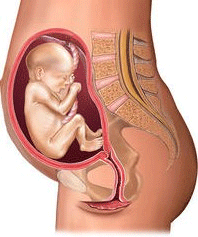
The baby is now about 17.5cm (7 inches) long and weighs approximately 270 gm (9 ½ ounces).
The baby is now producing meconium, which is the first stool, passed by the newborn in the first few days. This is made up of amniotic fluid, mucus, bile, lanugo, and is generally stored in the infant’s intestines. It is tarry, stick and dark However, sometimes the meconium is passed during or even prior to delivery.
Mom is passing on her immunities to baby now, helping protect the infant from illness and disease.
Another big development with baby is the refinement and growth of nerve cells for senses in different areas of the brain, leading to the ability to see, smell, taste, hear and feel. Babies can hear despite their watery surroundings, and will become accustomed to the voices and sounds of daily life. After being born, newborns will be comforted by familiar voices or music. Don’t think it’s silly to read, talk to, or sing to your growing baby. They are listening!
The baby’s heartbeat is so strong now you might even be able to distinguish it from your own.
The uterus should be at belly button level now.
Changes in your vision “worsen of eyesight”
- Temporary problem, as most the time the vision returns to normal after birth.
- The hormones cause drop in tear production and that dryness can lead to blurry vision or irritation.
- Fluid retention affects the shape of the eye, making contact lenses to become uncomfortable. If that’s the case, then trying wearing glasses for awhile.
However, some symptoms can indicate a problem with gestational diabetes or high blood pressure. Be sure to discuss with your doctor any problems you might be having.
Pregnant skin is different.
- Things which once may not have bothered you might cause a rash.
- Once oily skin might be dry, and vice versa.
- Skin is more sensitive than ever though, and thus direct sunlight should be avoided.
- Skin that is prone to stretch marks will become more problematic if exposed to sun. So if you must be in the sun particularly during the strongest exposure times, be sure to use sunscreen.
Baby now measures around 23 – 25 cm (9 – 10 inches) in length and weighs is about 340 gm (12 ounces).
Eyes are still closed. The tongue is developed and baby is practicing moving it about. Swallowing has increased, helping to prepare the system for digestion
The white blood cells are being produced, and will help fight off infections and disease.
Varicose veins are problematic for the majority of pregnant women. They generally appear in the legs and sometimes the vulva and rectum. They may or may not disappear after child birth. Often taking a regular time to rest with feet elevated is advisable.
Gestational diabetes is a fairly common pregnancy complication occurring in 4% of pregnancies. It is diagnosed by a glucose tolerance test, which is given around 24th week of pregnancy. If you are diagnosed with gestational diabetes, you will need to
- Keep monitoring your blood sugar levels
- Follow a diet
- Monitor your weight, exercise
If those don’t manage the condition adequately, you will need to take insulin.
Having gestational diabetes does put you at
- Higher risk of developing complication during pregnancy and labour
- Higher risk for developing diabetes later in life.
Now is the time to start getting serious about birthing plan.
Caffeine intake, the best move of course is to cut out all caffeine all nine months, but if you do partake, keep it within the recommended amount of 150-300 mg. a day (about one to two cups of coffee). Caffeine is both a stimulant and a diuretic.
Effects on your health
- Increase heart rate and Blood pressure
- Absorb less iron and calcium from food
Effects on baby
- Increase heart rate
- Can affect how much your baby moves
- As a diuretic, it can affect the amount of nutrition that your baby gets from you
The baby is now doll-sized, approximately 25 cm (10 inches) long and weighing almost 450 gm (one pound).
The facial features are becoming more defined, with brows and eyelids in position, lips distinct, and eyes have formed completely, yet the iris still lacks pigment.
The fingernails have grown to the ends of the fingertips and the hair is without pigment and is a shade of striking white.
The liver is beginning to break down bilirubin with help from Mom, and the pancreas is maturing.
Baby boys’ testes are descending into the scrotum, primitive sperm has formed, and testosterone is being produced.
The brain is entering a stage of rapid growth. Hearing is sharper.
The uterus is now just above the belly button.
Swelling, this is most obvious in your feet and ankles. This is more pronounced in warmer temperatures and later in the day. Swelling is a typical and harmless symptom, unless it doesn’t improve for over one day straight, and the face becomes puffy, consult your physician immediately. This could mean pre-eclampsia.
To combat swelling
- Avoid long periods of either sitting or standing
- Take frequent breaks
- Rest with your feet up
- Take short walks, or stretch
- Make sure you drink plenty of water throughout the day
Urinary tract infections are rather common during pregnancy. The hormones make you more susceptible to them. The symptoms of a UTI include:
- More frequent urination
- Difficulty emptying the bladder or starting urination
- Burning while urinating
- Urine that is cloudy or has strong odour
- Cramping in the lower abdomen or back.
If you think you may have a UTI contact your doctor. Most likely you’ll need to give urine sample for a culture and an antibiotic will be prescribed.
To avoid UTI’s
- Be certain to completely void your bladder while urinating
- Don’t wait too long to go to the bathroom
- Use good hygiene when wiping (always front to back )
- Wash hands frequently
- Staying hydrated is important too.
Now is the time to get signed up for childbirth classes. They involve a combination of relaxation and breathing techniques, and some are a mixture of techniques from various methods giving you a wealth of information and techniques to pull from in order to find what works best for you
Your choices might include
- Lamaze
The alteration of the perception of pain in childbirth through the use of the mind, as well as breathing and panting techniques
- Bradley
Focus is on partner-coached childbirth, as well as breathing techniques and mental relaxation
- Grantly Dick-Read
Reducing the use of pain-relief medication through abdominal breathing and panting
- LeBoyer
Emphasis is on gentle childbirth from the perspective of the newborn
Trying to quit smoking is an obvious and wise choice; however it is not simple even when faced with this most motivating reason. For those struggling to quit, don’t allow guilt to keep you from being honest with your doctor. Let him/her know how you are doing and be honest in order to get the best information and support in your struggle against nicotine.
Useful link
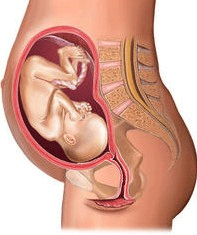
The baby is probably now just over 450 gm (1 pound) and a little over 28 cm (11 inches) long.
If born now, the baby has a 50% chance to survive till reaching Neonatal ICU. However, about 35% of those will survive till the discharge from ICU but about 60% of those who survive till discharge will have moderate to severe disability
Lanugo, the fine body hair, has darkened. The organs are still visible through the skin.
The uterus is now positioned directly above the bladder, which can be quite uncomfortable at times, and may also lead to leaking. It’s important to determine whether the liquid is urine or possibly amniotic fluid. Amniotic fluid is odourless, so if no smell is detected, contact healthcare provider immediately.
Skin issues are becoming more noticeable now as well.
- Linea negra, a vertical line running down your abdomen. It has always been there, but due to hyper pigmentation you might be aware of it for the first time.
- Stretch marks, appearing as dark pink or purple often, on stomach, breasts, hips, and buttocks. The good news, they will fade to a fainter hue after the baby arrives.
- Skin tags, they might disappear after baby’s birth, or you might need the doctor to snip them off.
- Red palms and soles
It’s important to remember that no medication or supplement should be taken without a doctor’s OK.
It’s definitely time to get your maternity leave settled with your employer.
Make sure you are doing the basics: staying well rested, hydrated, and getting some regular physical activity (as permitted.)
You might want to start practicing relaxation techniques, such as breathing techniques, visualization, stretching, and listening to relaxing music.
The baby is approximately 33 cm (13 inches) long and around 0.6 – 0.8 kg (1 ½ to 1 ¾ pounds).
It’s possible that the baby’s hair colour and texture might be apparent now, although many still have white hair due to no pigment yet.
The spine is getting more developed, with joints, ligaments and rings. The blood vessels of the lung continue to mature. The nerves around the mouth and lips have more sensitivity, which aids in the rooting reflex necessary for eating. Also the swallowing reflex is becoming stronger.
The baby can grasp things in his or her palm now, although the only thing available now is the umbilical cord.
Your uterus is now roughly the size of a soccer ball.
All the weight and the relaxed muscles and ligaments due to progesterone will make back pain a distinct possibility at this point. You will want to focus on not slouching and making an effort for good posture now to help with back strain.
Your legs also might get cramps frequently too.
Increased vaginal discharge might be occurring now. Talk to your doctor about when to call and what to look for in order to determine if it’s just a vaginal discharge, a bit of urine leaking, or amniotic fluid you are dealing with.
Hormones make your teeth a bit more susceptible to problems now, and this is no time for skipping good dental care. Some bleeding can become more common in pregnancy. Get regular dental care, making certain your dentist knows of your pregnancy. Any infections in your body, including in your teeth or mouth, can affect baby.
The baby is now about 35 cm (14 inches) long and around 0.9 kg (2 pounds).
The eyes have finally opened and the retinas are forming. Babies may be born with blue or gray-blue or dark eyes, however the colour can change up to the first six months of life.
The baby is now responding to touch more, and the movements are becoming more coordinated as the nervous system fine-tunes. However, all those baby gymnastics can become uncomfortable or even painful at times for mom. To deal, trying changing your position or stretching.
Baby boy’s testicles are now descending into the scrotum.
Constipation and haemorrhoids, to combat this problem, try to drink plenty of water, never strain with bowel movement and eat a balanced diet.
Braxton Hicks contractions, these are not painful but can be jarring if you aren’t sure what they are or what they mean. It’s just your uterus gearing up for the big day. You can differentiate between them and the real contraction by being aware of how regular the contractions are and if they are becoming harder or closer together. Braxton Hicks are irregular and do not peak.
Stem cells, the “building blocks” of all cells in the body and hematopoietic (blood) cells, which have the unique ability to develop into all the different blood cell types. Umbilical cord blood is the blood remaining in the placenta and in the umbilical cord after the birth of the baby; it contains a potent mixture of cells, including stem cells,
Stem cells are well-recognised for treating hematopoietic disorders, including Leukaemia and some cancers. Banking your new born stem cells ensures that those cells will be available for your child in the future.
Useful links:
Cellsence: 1800 005 541
Biocell: 1800 071 075
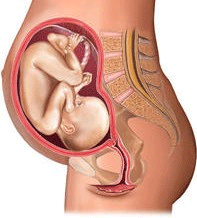
Baby is now 38 – 39 cm (15 and 15 ½ inches) long and 0.9 -1.3 kg (2 and 3 pounds).
Hair is becoming more noticeable, with lashes and brows getting longer as well as the hair on the head, although it is very much an individual trait now. Some babies will be born with full thick, long hair while others will have just a trace of fine hair.
At this point the baby is capable of breathing.
The baby will still be active but the uterus is so crowded that the movements are somewhat limited.
Uterus is so large now that the complaints associated with it are growing as well, such as heartburn, back pain, varicose veins, and fatigue.
The majority (about 85%) of population are Rh positive. However, if you are in the smaller group of Rh negative, you will receive a special shot “Anti D” around this point of the pregnancy. You’ll get another one at 34 weeks pregnant and a third once you’ve delivered the baby if the baby tested Rh positive. Also if anything occurs in the pregnancy where blood between you and the fetus might be in contact, you will require an additional shot.
This is an important time to begin doing kick counts and keeping track of them. What you want to get from the count chart is a reliable pattern. Then you can detect deviations from your baby’s normal activity level.
Now is definitely the time to decide on breast and/or bottle. Yes, breast is best, but if there are certain issues that you have to overcome to do it and you attempt it out of guilt you might be setting yourself up for extra stress.
Some women go into it planning on a limited time to nurse, but discover it’s easier than they expected and continue nursing longer. Others won’t hear of using bottles, but life forces it upon them due to unexpected circumstances.
Breastfeeding is a natural activity, but that doesn’t mean it comes naturally to all babies and mothers. It is a learned skill so most mums need some help along the way. The Australian Breastfeeding Association (ABA) provides a high quality of knowledge and practical breastfeeding support for mothers. Their web site can be accessed from the following link. http://breastfeeding.asn.au
At this point in your pregnancy, you might be feeling less like exercising. You want to be as active as you safely can.
Baby will be rapidly gaining weight now until delivery, and will double or maybe triple present weight.
The baby’s head is in proportion, and the head is growing along with all the brain expansion. The brain is controlling breathing and maintaining body temperature, although not perfectly.
Baby will be moving to a head-down position in the next few weeks; however some babies will pop back and forth making it a guessing game until the end.
Remember a high fibre/grain diet, plenty of fluids, regular exercise help to overcome constipation. If that’s not enough, Metamucil or Benefiber should be good. DO NOT use a laxative or mineral oil while pregnant.
Varicose veins, less than 50% of all pregnant women experience varicose veins. They might just be unsightly, or they can cause discomfort or pain. Avoid heavy lifting, keep your weight on track, and avoid prolonged sitting and standing which keeps you from having good circulation. They should improve or go away within a few months of delivering baby.
It’s a very good idea to sit down with your partner and have a very honest talk about realistic expectations not just for the birth, but how your partner thinks he/she will handle it all.
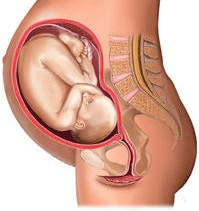
Your baby is now around 41 – 43 cm (16 ½ and 17 inches) in length and about 1.8 – 2 kg (4 – 4 ½pounds).
While the baby is growing, the movements may seem less than previously. That is partly due to the fact that there is less room to negotiate in there now.
Baby’s hair continues to grow and toenails have completely formed.
Most likely, the baby is head-down now, but not to worry if he or she’s still bottom down. Most babies will turn before labour, even though the uterus is more crowded.
Researchers say babies at this stage dream, although they only sleep in half-hour segments generally.
Braxton Hicks, if you are a first time mom, you might not even notice them, however as you get closer to birth, Braxton Hicks contractions will get stronger and longer. If you are unsure if it’s the real thing, switch up your activity. If you were resting, get up and walk. If you were busy, then take a warm bath or put your feet up. Real labour can’t be abated by changes in activity.
The Paediatrics and Child Health Division, The Royal Australasian College of Physicians (RACP) has prepared a statement on routine circumcision of boys to assist parents who are considering having this procedure undertaken on their male children. After extensive review of the literature the RACP reaffirms that there is no medical indication for routine neonatal circumcision.
The RACP policy on circumcision can be sited at the following link http://www.racp.edu.au/index.cfm?objectid=D7FAA93E-E091-4209-15657544BA419672
Baby is getting more complex with activity, able to breathe and suck, and squirm simultaneously now. The skull and skeleton are complete but still soft, making birth much easier on you both.
Amniotic fluid has topped out at its max level this week.
Baby has reached important stage in development this week, as the immune system is developed now. That and the antibodies passed on by mother will enable baby to handle life outside the womb.
The leukorrhea discharge is increasing; it should be thin and milky white with a non-offensive odour. If the discharge is tinged green or yellow, or bloody, it’s not typical. If there are accompanying symptoms such as burning, itching or redness, again this is not expected with leukorrhea.
If you are soaking pads and it’s not urine, leakage of amniotic fluid might be suspected.
Fundal height is a bit of a predictor of a few things. It should match up to the weeks you are pregnant. It is reliable after 24 -28 weeks gestation. The measurement is from pubic bone to top of uterus.
A smaller than expected fundal height might indicate:
- A smaller baby
- Baby in birth position sooner than expected
- Less than usual amount of amniotic fluid
- Breech baby.
A larger than expected fundal height could indicate
- A Bigger baby
- Multiple pregnancy
- A full bladder
- More than usual amount of amniotic fluid
If the doctor thinks the measurement is off, an ultrasound may be performed to check it out.
New 3D ultrasound technology has given rise to commercial ultrasound businesses. This is a somewhat controversial idea, since some doctors have concern that non professionals and worrying parents might see problems in a scan since they have no medical training or that even the long term consequences of ultrasounds is unproven. Do not attempt to read more into it than a charming keepsake.
The baby is now about 44 cm (17 ½ inches) long and weighs over 2.2 kg (5 pounds).
The fingernails have grown long enough that baby can actually scratch his or her own cheek. Baby is blinking and responding to light.
The nervous system is maturing and developing, with connections multiplying rapidly in the brain.
The testicles of baby boys are descending.
Eversion of the belly button may is common in pregnancy. Remember it’s not a permanent state.
Belly itchiness, some itching is normal with the stretching marks and can be helped with lotion and possibly calamine lotion. If you have red raised patches that are intensely itchy and it spreads to your limbs, it could be pruritic uricarial papules and plagues (PUPP). This can be treated with medication and creams. Another itchy problem is due to a dysfunction of the liver, called Cholestasis. This itchy condition is accompanied by nausea, fatigue and loss of appetite and is diagnosed through blood tests. It can be treated with medication.
If you are in the smaller group of Rh negative women, this is the time for your second Anti D shot.
Make a list to take with you to your antenatal visit. Ask y questions about
- Signs of early labour
- What to expect during and after labour
Episiotomies are cuts made in the perineum to aid in birthing the baby. Routine episiotomies are not the norm anymore, but still occur in significant portion of births. Some people advocate perineal massage to avoid this procedure, beginning with massaging the area at week 34.
Insomnia may become problematic, to ensure adequate rest, you might need to master the art of napping. Prop up your feet, put on an eye mask and soak up a few minutes of blissful peace. Make a comfy nest of pillows and lie down on your side with some calming music playing softly in the background.
The baby is now probably 2.4 kg (5 ½ pounds) and about 43 – 45 cm (17 or 18 inches) in length.
The liver is functioning, processing wastes and the kidneys are fully developed. If the baby were to be born this week, most likely there would be no serious complications.
Soon some of the pressure against your diaphragm will decrease, and your breathing will be easier again. That’s because the baby will descend deeper into the pelvis. This is called lightening. However, the baby will then be putting more pressure on your bladder, leading to frequent urination and possibly urine leakage, especially when you laugh, sneeze or cough. Doing Kegel exercises will help with the leaks. Don’t curtail liquids to lessen the urine output, you need those fluids. Be sure to completely empty the bladder as well, and lean forward a bit to help with that. Just be certain to hold on to something, as your balance is not the best at this point.
Now is a good idea to find out more about Caesarean sections, as it is a fairly common occurrence. Being prepared for the possibility will ease some fears later if it becomes a reality. Ask your doctor what the standard protocol is. Would your partner be present to view the birth and sit at your head during the procedure? What can you expect if you have a C-section at the hospital where you are giving birth?
Have you given any thought to the grandparents in planning the birth? How are they going to be involved? Will you invite them to come to the hospital during labour, or wait til after the birth? Will someone be coming to stay with you after you bring baby home?
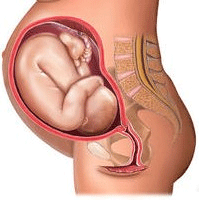
The baby is now about 45 – 48 cm (18-19 inches) long and around 2.7 kg (6 pounds). However, every baby has their own growth rate, especially at this point in the pregnancy.
The fuzzy lanugo and creamy substance vernix caseosa is disappearing as birth approaches. The vernix caseosa protected the baby from the amniotic fluid.
Most babies are head-down at this point, but if yours still isn’t, don’t worry. There is stii time.
The lungs are still developing.
The baby is gaining an average of 200 gm weekly body weight.
Pelvic pressure is becoming pronounced now, as the baby has descended down in preparation for birth. Also those pregnancy hormones have loosened up your joints, so the pained tired waddle of the very pregnant woman has likely become your new walk. To relieve the pain, try
- Applying heat and taking warm baths
- A massage
Besides pelvis pressure, you can expect more heartburn, legs cramps and back pain.
Night mares are an odd part of late pregnancy. These often express the stresses and fears about impending parenthood, or anxieties about the labour or the unknowns ahead in life with baby.
Around 35-37 weeks, a vaginal swab is taken to screen for Group B Strep. This is a bacterium that is not uncommon in healthy women (between 15-40%) and can be found in vagina or rectum of pregnant women. While the bacterium doesn’t necessarily get passed onto baby while pregnant, it can be transmitted to the baby while in labour and can cause serious problems, so the screening is a good preventative course of action. If the result of the culture is positive, you’ll receive IV antibiotics during labour. Giving antibiotics prior to labour is pointless, since the bacteria can come back before labour and pose same risks to baby. If the result of the culture is negative, you’ll not require antibiotics in labour. If for any reason you missed the GBS screening, don’t panic, the doctor will discuss if you are in the low or high risk group. High risks include rupture of membranes or labour prior to 37 weeks, fever during labour, previous GBS birth and urinary infection during the pregnancy due to GBS. If you are in high risk category, you’ll receive IV antibiotics during labour.
You will be seeing your doctor every week and soon you might get word on if the baby is head down, or get your cervix examined and some indication if you’ve begun to efface or dilate. Everyone has her own timing and pattern, and just because nothing has happened yet doesn’t mean it’s going to take forever.
It’s a good idea to get the baby’s bag packed and ready for the hospital now.
Your baby is officially full term this week. That means while every day baby stays in the womb is good, if your baby were to be born this week, everything should go smoothly.
The baby is likely over 48 cm (19 inches) and around 2.9 kg (6 ½ pounds.
The baby is staying quite busy practicing for being a newborn, “breathing” by inhaling/exhaling amniotic fluid, sucking on thumb or fingers and blinking.
Amniotic fluid is on the decrease, and Braxton Hicks contractions are on the increase.
Losing the mucus plug “the show” is one of the physical changes some women undergo before actual labour begins. When the cervix begins to thin and dilate, you will eventually lose that mucus plug. The mucus plug has been present at the opening of your cervix to prevent bacteria from entering. It can be clear and stringy, or pink or blood-tinged and sticky. Some women may not even notice losing it, as the vaginal discharge has become so heavy towards the end of the pregnancy. While it’s a sign labour is on the way, labour might be hours away or days or even weeks.
However, if the discharge is suddenly bright red, call your labour ward immediately. That could signal a placenta problem and requires quick care.
The big focus now will be on looking for signs of labour. The doctor will be checking the baby’s position in relation to your pelvis, termed “engagement”.
Your baby’s organs are developed and fully functional. However, the lungs and brain will continue to develop and grow after the child is born.
The baby’s first bowel movement is in the making. Meconium, the sticky greenish or dark first bowel motion baby has, is mostly made up of things collected in his/her digestive tract during gestation.
You’re probably curious what baby will look like. Baby might have a full head of long hair, or be a little fuzz ball when born. Unless born with brown eyes, which will most likely remain brown, babies’ eye colour can change up until nine months of age or so.
Leaky breasts are a sign your body is preparing to nurse your baby. Colostrum is thin and yellow and a pre-milk, rich in antibodies baby needs at birth. It will be a few days after the baby is born before your real milk comes in. For now, if the leaking is bothering you, use nursing pads to protect your clothes from getting soggy.
This week at your doctor’s visit, take a notepad and ask the following important questions.
- When do I go to the hospital?
- How long should I let contractions go on, how far apart?
- What if I think my water broke?
- What kind of pain is more serious and requires immediate attention?
This is the time to decide on contraception. If you are breastfeeding you need to talk to your doctor with that in mind.
Your baby’s organs are developed and fully functional. However, the lungs and brain will continue to develop and grow after the child is born.
The baby’s first bowel movement is in the making. Meconium, the sticky greenish or dark first bowel motion baby has, is mostly made up of things collected in his/her digestive tract during gestation.
You’re probably curious what baby will look like. Baby might have a full head of long hair, or be a little fuzz ball when born. Unless born with brown eyes, which will most likely remain brown, babies’ eye colour can change up until nine months of age or so.
Leaky breasts are a sign your body is preparing to nurse your baby. Colostrum is thin and yellow and a pre-milk, rich in antibodies baby needs at birth. It will be a few days after the baby is born before your real milk comes in. For now, if the leaking is bothering you, use nursing pads to protect your clothes from getting soggy.
This week at your doctor’s visit, take a notepad and ask the following important questions.
- When do I go to the hospital?
- How long should I let contractions go on, how far apart?
- What if I think my water broke?
- What kind of pain is more serious and requires immediate attention?
This is the time to decide on contraception. If you are breastfeeding you need to talk to your doctor with that in mind.
The average baby weighs around 3.4 kg (7 ½ pounds) and is about 50 cm (20 inches) long. Boys tend to be larger.
Your baby is 15% fat, meaning it’s not easy to regulate that temperature and stay warm. Don’t worry, the hospital will help you keep baby warm in those first couple days.
Up to 75% of baby’s body is water.
Baby’s nails have grown so much that you might just need to clip them soon after birth. Many newborn gowns have little sleeves that fold down over the hands to prevent baby from scratching him or herself.
Don’t be surprised if at birth your baby’s breasts seem rather swollen, even boys are affected by hormones during birth and have little breast buds.
Baby’s bones have hardened some, except for the skull. The skull remains softer to allow for bones to overlap and contract during birthing process. There will also be two soft spots, or fontanelles, on top of the head which will close up within several months. The downside to the flexibility is an odd shaped, or most often, cone-shaped head for the first few days of life.
About half of all pregnancies last past 40 weeks, but all will end at 41 weeks and three days either with going into labour on their own, or by being induced.
Most labours do not begin with water gushing. Rupture of membranes prior to labour starting only happens 15% of the time. And usually it’s not a gush, but more of a trickling slow leak. However, once the water has broken, labour will begin. In fact if it doesn’t within 24-48 hours, labour should be induced due to risk of infection.
You might either feel a rush of energy as you await labour, or perhaps feel very tired, but most likely the only thing you can think about is “Will baby be here today?”
As you near the end of the pregnancy, and still haven’t started labour you might start wondering about induction.
Conditions that might call for induction
- Gestational diabetes, pre-eclampsia, hypertension or bleeding
- If we are concerned about the baby’s wellbeing.
Pregnancies are rarely allowed to continue beyond the 41weeks and three days, as the placenta will not be able to support the baby past that time.
When inducing labour, we typically use a medication, called Prostaglandin suppository in the vagina to help jumpstart labour. Another medication that will start labour is Oxytocin, usually administered through an IV drip, and will be carefully monitored as it can stimulate too hard of contractions which will lead to needing pain management medications. Another method for starting labour is artificially rupturing the membranes.
Your queries are best answered over the phone, our friendly reception staff would be happy to assist you with your enquiry, contact us on +02 8824 4998
 Dr Emeil Kamel
Dr Emeil Kamel Dr Emeil Kamel
Dr Emeil Kamel